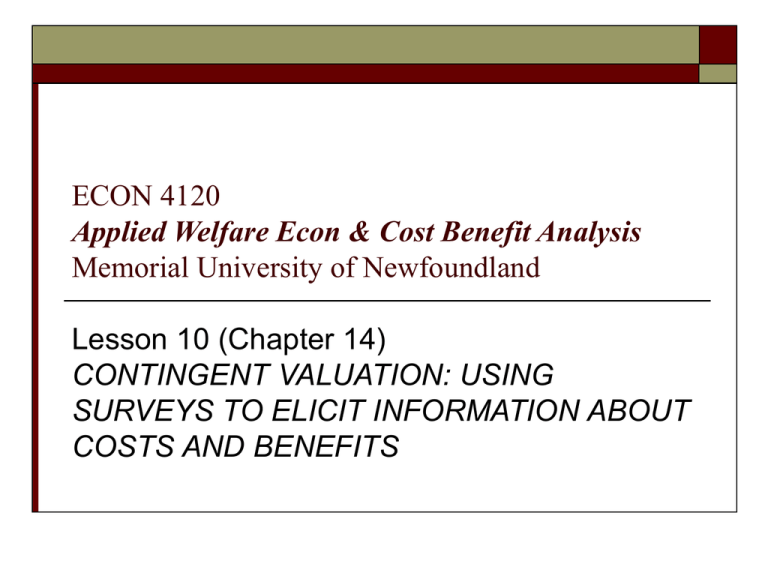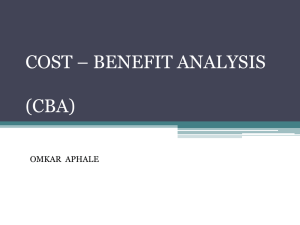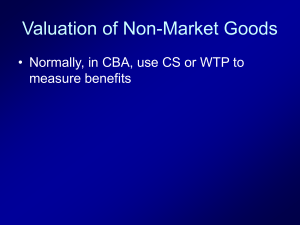
ECON 4120
Applied Welfare Econ & Cost Benefit Analysis
Memorial University of Newfoundland
Lesson 10 (Chapter 14)
CONTINGENT VALUATION: USING
SURVEYS TO ELICIT INFORMATION ABOUT
COSTS AND BENEFITS
Purpose
Overview of contingent valuation (CV)
surveys, review criticisms of CV, and consider
the strengths and weaknesses of the most
commonly used CV methods.
Purpose
For some public goods, there are no obvious
ways to determine preferences through
observation of behaviors => no option to use
revealed preference methods
In these cases, there may be no alternative to
asking a sample of people questions about
their valuations.
Purpose
The primary use of CV is to elicit people’s
Willingness-to-Pay (WTP) for changes in the
quantity of a good.
Valuing “use” or “potential use” goods with
CV is relatively non-controversial.
Valuing passive use (nonuse) goods with CV
is more controversial.
Stated versus revealed preference methods
We can ask them => stated preference
methods (Contingent Valuation)
We can try to infer it from their behaviour
in other markets => revealed preference
methods
The latter include the Travel Cost Method
and the Defensive Expenditure Method,
both based on the Production Function
Approach, and Hedonic Price Methods
Stated versus revealed preference methods
Revealed preference methods exploit the
idea that some environmental
goods/services are related to marketed
goods
In particular, we may want to find
substitutes or complements of those
environmental services we want to value
Stated versus revealed preference methods
With stated preference methods, we do not need
that
We simply ask!
Example of these methods include contingent
behaviour, conjoint analysis, choice experiments,
contingent ranking and other complex procedures
in constant developing
They are all based on asking individuals to state a
preference and inferring information from that
We will focus on the contingent valuation
method
Contingent Valuation
Contingent Valuation Methods (CVM) try to
directly get the values of WTP or WTA by
interviewing a sample of consumers and
presenting them with a hypothetical market
We want to ask about WTP contingent on the
existence of a market
CVM steps
Set the hypothetical market
obtain bids
estimate mean/median WTP or WTA
estimate bid curves
aggregate the data (from sample to
population)
evaluate your CVM exercise
Set the hypothetical market
Describe the hypothetical environmental
market, make it realistic and informative
What is the environmental good?
How would the payments be made? (bid
vehicle)
Who would pay? When? How often? How?
Obtain bids
Obtain the WTP/WTA for the environmental good
using a certain type of elicitation format :
a bidding game (higher and higher amounts are
suggested until the maximum WTP is reached)
close-ended referendum (so we get just a
YES/NO answer) aka dichotomous choice
Sometimes a compromise is the double-bounded
dichotomous choice format
Obtain bids
Obtain the WTP/WTA for the environmental good
using a certain type of elicitation format :
as a payment card (suggesting different values to
choose from)
as an open ended question: “How much?” (this is
quite difficult to answer normally)
Obtain bids
Obtain the WTP/WTA for the environmental good
using a certain type of elicitation format:
Exploit the idea of contingent behaviour: how
many trips would you make? How many wolves
would you sponsor?
Obtain bids
Obtain the WTP/WTA for the environmental good using a
certain type of elicitation format:
Contingent Ranking Method: rank specific feasible
combinations of the good being valued and monetary
payments.
An example would be low water quality and low taxes vs.
high quality and high taxes, including several
combinations in between.
Obtain bids
Obtain the WTP/WTA for the environmental good using a
certain type of elicitation format:
This method makes it is easier for the respondent to
answer (ordinal procedure).
The WTP must be inferred from the rankings, however,
rather than being directly elicited. Also, responses tend to
be sensitive to the order in which the alternatives are
given.
Obtain bids
Obtain the WTP/WTA for the environmental good
using a certain type of elicitation format.
You must also frame the question within a
realistic scenario, who is going to pay?
Yearly? Only once? Will it be compulsory?
A tax?...
Obtain bids
Obviously the survey needs to be
administered
It may matter whether you use mail, phone,
internet, or in-person surveys
Sometimes it matters the clothes the
interviewers wear!!!!
Desirability bias could be an issue
Estimate mean/median WTP or WTA
From the sample calculate an average bid,
normally the mean and the median (which
disregards extreme answers) are used
Check for protest bids (zero WTP or
ridiculous WTA) and other outliers
Estimate bid curves
Then try to investigate why different people
give different answers
Estimate WTP as a function of income, sex,
age, education, and level of environmental
good bid for (scope)
Estimate bid curves
Imagine you ask people whether or not they would
be willing to pay $X dollars for a certain
environmental improvement.
If you ask different people about different amounts,
you can track the relationship: the probability that
they agree with the payment should decrease with
the size of the bid
This is the essence of it
Aggregate the data
Aggregate the data (from sample to
population)
What is the relevant population?
Did we use a really random sample or does
the exercise need correction for sample bias?
If the aggregation is over time, what type of
discount rate do we use?
Evaluate your CVM exercise
Sources of biases:
strategic bias (associated with free-riding)
If the respondents think that the real
payment may be related to the hypothetical
answer => understate (free ride)
If the respondents think that the real
payment will not be related to the
hypothetical answer => overstate if you
think that the value for you form the good
exceeds the expected payment!
Evaluate your CVM exercise
Sources of biases:
design bias (sample bias, non-response
bias, bid vehicle bias, starting point bias,
information bias, given changes WTP, so
WTP and WTA values become endogenous
to the valuation process, interviewer bias)
Evaluate your CVM exercise
Sources of biases:
Mental account bias (would they spend all
their money to save the tigers and all they
money to save the whales???)
This is also related to the notion of scope
bias. Sometimes the respondents give the
same WTP for saving one wolf, for 100
wolves, and for all wild mammals! (see
Embedding Effects)
The main advantage of CVM
It is the best method, the only one, to
ascertain non-use values!
Including:
Existence value
Bequest value (which some really consider
a type of use value)
Option Value (which some really consider
a type of use value)
The main advantage of CVM
It is the best method, the only one, to
ascertain non-use values!
This is because you do not need to observe
any behaviour in any type of real market
Therefore you can value anything
The main disadvantage of CVM
It is all hypothetical
This is because you do not observe any real
behaviour in any type of real market
It is a bit wishy-washy for some
Traditionally, economists prefer to observe
the choices made about real things paid by
with real money
The main disadvantage of CVM
Traditionally, economists prefer to observe
the choices made about real things paid by
with real money
In this sense, it is interesting to compare
the results of the valuation of something
that can bought for real using CVM and
using real data
Often the CVM overestimates WTP
Other disadvantages of CVM
There are other, more technical disadvantages
you do not need to worry about at this stage
They have to do with the distinction between
WTA and WTP
And also, for most elicitation formats with the
way to go from the answers to the question to
some form of demand curve
The econometrics are complex and need many
assumptions to be made by the researcher
Other disadvantages of CVM
Apart from that, there is a variety of biases
that can affect CVM
A well designed study that aims at avoiding
those biases can become very costly!
Using up too many resources to get to
know how much something is worth is not
really great!
Philosophical disadvantages…
These are common to other tools related to
cost-benefit analysis of course…
Should humans’ opinion be the only one
that counts???
Why don’t we just ask the experts, instead
of asking everyone?
Philosophical disadvantages…
WTP depends not only on how much one
likes/needs something: WTP depends on
ability to pay
The values of environmental goods are a
function of incomes
If the distribution of income changes the
estimated values could change!
Keywords
stated preference methods
Contingent Valuation Method (CVM)
revealed preference methods
sample bias
protest bids
outliers
Keywords
strategic bias
design bias
bid vehicle
starting-point bias
Mental account bias
non-use value
existence value
Bequest value
Option Value
NEXT
More on shadow prices
READ CHAPTER 15








